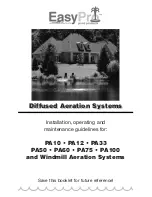
1.9
Good pump installation practice
Position
Thepump mustbemounted in theuprightposition and notinverted or placed on itsrear face.
It is recommended that the pump is sited on a flat, horizontal, rigid surface, free from excessive vibration,
to ensure the correct lubrication of the gearbox and correct pumphead operation. Allow a free flow of air
around the pump to ensure that heat can be dissipated. Ensure that the ambient temperature around the
pump doesnotexceed therecommended maximum operating temperature.
Do not stack more than 2 pumps on top of each other. The case’s third row of feet ensure ventilation
between pumps and allow the top pump to be set back a little to give clear access to the lower pump’s
keypad. When the pumps are stacked, ensure that the ambient temperature around all the pumps in the
stack doesnotexceed 40C.
Emergency disconnection
The pump’s external DC power supply is the disconnecting device, which must be readily identifiable and
easily reached, for isolating themotor drive from themainssupply.
Note: There may bea slightdelay after isolating thepump before thepump stops.
Valves
Peristaltic pumps are self-priming and self-sealing against backflow. No valves are required in inlet or
discharge lines. Valves in the process flow must be opened before the pump operates. Users are advised
to fita pressure relief device between thepump and any valve on thedischarge sideof thepump to protect
againstdamage caused by accidentaloperation with thedischarge valve closed.
Pressure advice
In most circumstances, rotor and tube life are maximised if the pumphead is run slowly, particularly when
pumping athigh pressure. Do notexceed thepressuresshown here.
120 pump RMS pressure ratings
120F + any pumphead
0 bar
120S+102R
120S+400DM2
120S+400DM3
120U+114DV
120U+400D1
120U+400DM2
120U+400DM3
2 bar
m-120-en-02
10











































